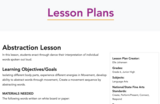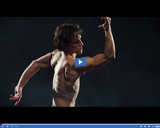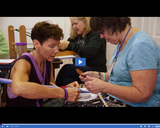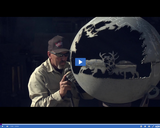
Stories about Navajo Four Seasons, Native American Cradleboards, Pia Toya Story, Parent Committee Special Projects, and Powwow Dancing.
- Subject:
- Arts and Humanities
- Dance
- Literature
- Date Added:
- 03/16/2021

Stories about Navajo Four Seasons, Native American Cradleboards, Pia Toya Story, Parent Committee Special Projects, and Powwow Dancing.

The Apache Crown Dancers are enrolled members of the White Mountain Apache Tribe and live in Whiteriver, Ariz. In this video segment, the group leader, Joe Tohonnie, Jr., talks about the long history of the dance and its role in Apache culture as the dancers perform Crown Dances.

Joe Allred, leader of the Lexington, KY.-based Capoeira Narahari, discusses the basics of Capoeira and its origins in Brazil in this video from the Dance Arts Toolkit series.

In this video John Bullet Standingdeer a member of the Warriors of AniKituhwa of Cherokee, NC, describes the cultural importance of the ceremonial Eagle Dance, performed by the Warriors of AniKituhwa, and the social Beaver Dance, performed by the Raven Rock Dancers.

Curtis Lazore, a member of the Oknegakdagye (Along the Waters) Dancers, talks about the dance traditions of the Mohawk in this video from the Dance Arts Toolkit series.

Tamisha Floyd, one of four captains of the Step Team at Bryan Station High School in Lexington, Ky., describes stepping in this video from the Dance Arts Toolkit series. She also describes how her team learns and practices its routines.

Dancer Lakshmi Sriraman talks about the bharatanatyam, a classical dance from India in this video from the Dance Arts Toolkit series.

Cheryl Pan, a dancer from China, talks about the Chinese fan dance and shows a variety of fans used in Chinese dances in this video from the Dance Arts Toolkit series.

Jingzian Zhang, a retired professor of Chinese opera, talks about the purpose and form of the Chinese Sword Dance in this video from the Dance Arts Toolkit series.

Jeaunita and Adebola Olowe of Bi-Okoto Drum & Dance Theatre talk about the Sohu, a ritual cleansing dance from Togo, in this video from the Dance Arts Toolkit series.

Jennifer Rose, a dancer, musician, and folk historian from Berea, Ky., talks about the background of the Tarantella, in this video from the Dance Arts Toolkit series. The Tarantella is a folk dance that originated in Italy.

Adebola and Jeaunita Olowe discuss Nigerian culture and dance and how they started an African dance company in the United States in this video from the Dance Arts Toolkit series.

In this lesson, students enact through dance their interpretation of individual words spoken out loud.

Pursuing a career in the theater can seem intimidating and overwhelming. In this video from Treasures of New York: The Drama League, students receive advice from successful theater professionals like director Diane Paulus and actress Judith Light. From practical suggestions like staying informed by reading the newspaper, to more general advice like finding one’s passion, students hear from and are inspired by the words of experienced artists.

In this lesson designed for kindergarteners, students experience the alphabet through movement.

Learn about the physical characteristics of environments and act out the animals that live there!
You are the next contestant on the Take the Stage game show ANIMAL SURVIVAL where you will travel in a hot air balloon to the forest of North America, the savanna of Africa, and then take a submarine ride underwater in the ocean. To play the game, you will act out an animal that would live in each environment, and then write how the physical characteristics of each environment helps your animal survive.
Learning Objective: observe and describe the physical characteristics of environments and how they support populations and communities of plants and animals within an ecosystem.

Learn about actress Anna May Wong—the first Chinese American Hollywood movie star, producer and one of the most influential style icons of her time, in this resource from Unladylike2020. Throughout Wong’s career, she encountered racism and stereotyping in the roles she was offered, but in the end she found a way to flourish as an actor on her own terms starring in 60 films. Using video, discussion questions, vocabulary, teaching tips, and an in-class activity, students learn about Wong’s place in Hollywood history and how she was impacted by important events in American history, like the Chinese Exclusion Act of 1882 and anti-miscegenation laws.

Cervilio Amador, principle dancer for the Cincinnati Ballet always enjoyed the freedom of movement he found in ballet. But "freedom" took on a new meaning when he defected from Cuba to the United States. Architects at kinneymorrow architecture explain how they transformed an old home into their Houston Texas-based office space. Mequon, Wisconsin, oil painter Pamela Ruschman shares her great love for Wisconsin's landscapes and livestock in her paintings. She brings out the personalities of her beloved farm animals in her works. A person-to-person cultural exchange in Colorado where a music teacher connects with a violin student in Rwanda from inside a re-purposed shipping container with high-tech connections.

Located in their own historic house built in 1842, the Weavers Guild of greater Cincinnati offers classes, workshops, and programs to people of all skill levels. Music therapists work at a children's hospital in Sacramento, California. Learn about the art of Japanese drumming from the performers of the Tampa Taiko ensemble. A series of artworks help Houstonians connect on the bayou.

Welder Jim Moffitt of Fernley, Nevada, has transformed his passion for metal working into 360¡ works of art. See how he creates intricate fire pits with an artistic flair. The City Girl Farm is a place from which chicken footstools emerge. And they donÕt go for chickenfeed either. TheyÕre serious pieces of fiber art. A question of faith lies at the heart of Disgraced , a Pulitzer Prize winning play. ItÕs a wrenching conflict given that the main character at the center of it is at pains to conceal his background because heÕs Muslim. Karen Barsy has been a dance therapist for over 25 years. She works in different places throughout metro Detroit. LetÕs check out Karen and the amazing advances dance therapy can achieve.